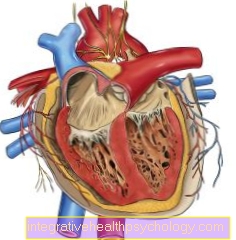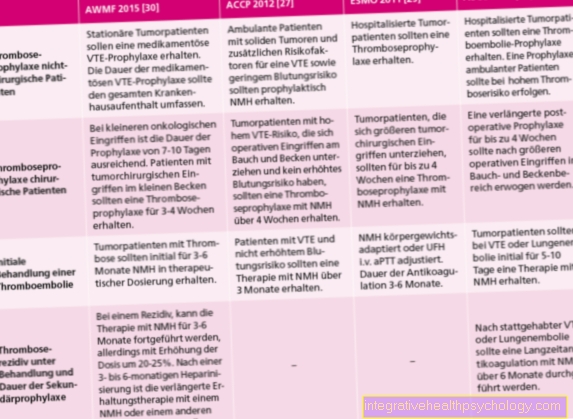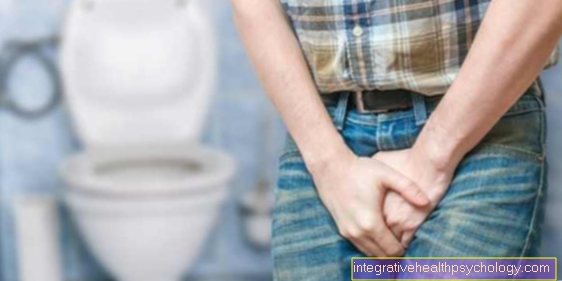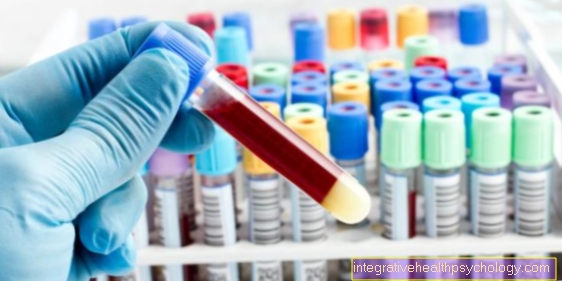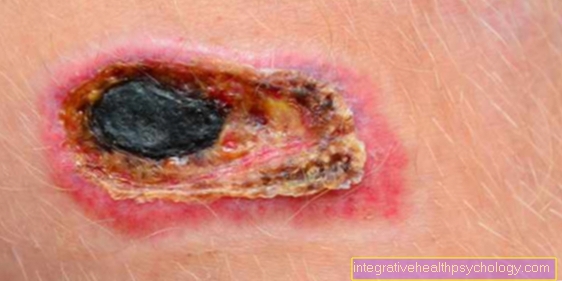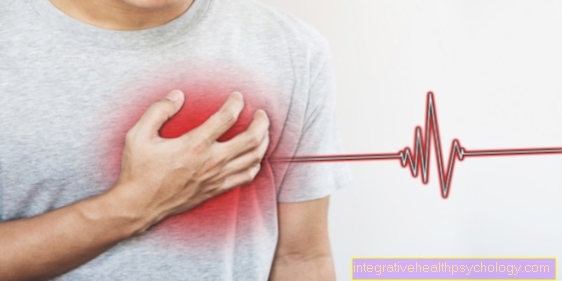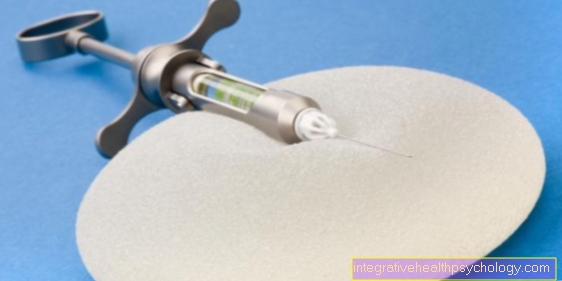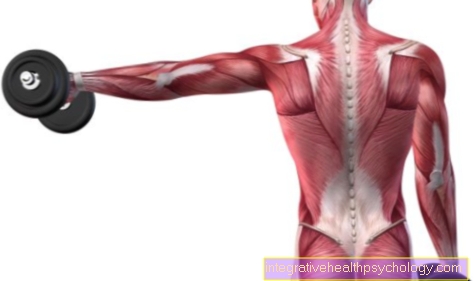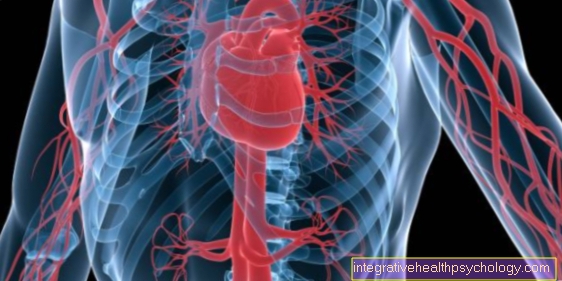The inguinal canal
General
The inguinal canal (Canalis inguinalis) is located in the groin region and runs over the inguinal ligament (Lig. Inguinale) through the abdominal wall. The inguinal canal is an important anatomical part of the body: it contains various structures (nerves, ligaments, blood vessels ...) and protects them in their course. At the same time, the inguinal canal is also a weak point in the human body, as it is there that inguinal hernias can occur.
Read more about the topic here: Inguinal hernia

Anatomical structure
To the limiting structures of the canal include muscle tendons and ligaments.
- The roof - i.e. the cranial / upper limit - of the inguinal canal is delimited by the tendon plate (aponeurosis) of the internal oblique abdominal muscle (M. obliquus internus abdominis) and the external oblique abdominal muscle (M. obliquus externus abdominis).
- The floor (lower / caudal limitation) of the canal represents the lower edge of the tendon plate of the external oblique abdominal muscle, which continues as the reflex ligament to the linea alba after it has once punched itself backwards. In addition, the tendon plate is Inguinal ligament reinforced.
- Forward the canal is also limited by the tendon plate of the external oblique muscle.
- The back wall (rear / dorsal border) is formed by the inner abdominal wall fascia (Fascia transversalis abdominis).
The length of the channel is about 4 cm.
One distinguishes two openings, the outer, medial and the inner, lateral opening.
- The lateral opening (annulus inguinalis profundus) can be seen through the radiation of the inner abdominal wall fascia. The abdominal wall fascia (also called processus vaginalis here) envelops the spermatic cord in men and then continues with it. The vaginal process recedes in women. If this does not happen, a so-called nuck cyst or female hydrocele can be seen.
- The middle (medial) opening (annulus inguinalis superficialis) is bounded back and down by the crus laterale of the tendon plate of the external oblique abdominal muscle and bounded forward and up by the crus mediale of the same tendon plate. Both crura are connected to each other by connective tissue (Fibrae intercrurales). The superficial abdominal fascia covers the opening and runs around the spermatic cord in men.
Function of the inguinal canal
The inguinal canal serves to protect many structures in its course. Both the male and female inguinal canals contain the ilioinguinal nerve from the lumbar plexus, the genital branch from the genitofemoral nerve, lymph vessels in the groin region and blood vessels. These structures use the inguinal canal to exit the abdominal cavity. This is the only way they can cross the hard abdominal wall and reach their target structures.
In men, the spermatic cord and various vessels that supply the testicles also run through the canal. As the fetus develops, the testicles must leave the abdominal cavity to get into the scrotum. The testicle uses the inguinal canal, which is a connection between the abdominal cavity and scrotum, and pulls its supply vessels and part of the inner abdominal wall fascia with it. This is how the so-called vaginal process arises. This phenomenon is also known as testicular descent (Descensus testis).
In the female inguinal canal there is also the uterine ligament (ligamentum teres uteri), which connects the corner of the tube and the large labia.
Differences between the male and female inguinal canals
The male and female inguinal canals differ most by their content.
- Female inguinal canal: The content of the female inguinal canal includes the Ilioinguinal nerve, the Genital branch of the genitofemoral nerve, Lymphatic vessels as well as that Maternal ligament (ligamentum teres uteri) and its supplying Artery (Arteria ligamenti teres uteri).
- Male inguinal canal: It contains a significantly larger number of structures. The most concise structure is the Spermatic cord (Funiculus spermaticus) It includes, among other things, the Spermatic duct (ductus deferens), as well as various Artery, veins and nerves which serve to supply the testicle and the surrounding structures. You can also find the obliterated vaginal peritoneal process in the inguinal canal, which is responsible for the development of Inguinal hernias or Water breaks can lead if it is not completely closed.
The ilioinguinal nerve runs outside the cervical ligament in women and outside the spermatic cord in men.
Inguinal hernia
Inguinal hernias (also known as inguinal hernias) occur when viscera enter the inguinal canal.
An inguinal hernia is located above the inguinal ligament, in contrast to the femoral hernia, which is located below the inguinal ligament. Inguinal hernias are very common and preferentially affect men (4: 1).
If possible, inguinal hernias are generally reduced manually. If manual repositioning does not seem possible, the hernial sac is surgically returned. In the case of frequent inguinal hernias, one can consider reinforcing the hernial orifice interventionally using a mesh.
Read more about the topic here: Symptoms of an inguinal hernia.
A distinction is made between a direct (medial) and an indirect (lateral) inguinal hernia. The hernial orifice of the direct (medial) hernia is located in the Hesselbach triangle, in the medial inguinal fossa (fossa inguinalis medialis). This type of hernia is always acquired, unlike the indirect hernia.
The lack of muscle in the Hesselbach triangle explains why direct hernias tend to take place at this point: the inner abdominal wall fascia can only withstand increased pressure in the abdominal cavity with difficulty. After the abdominal viscera emerges, they run through the inguinal canal to the medial opening (anulus inguinalis superficialis). In indirect (lateral) hernias, the hernial sac runs through the peritoneal vaginal process.
This can happen if the vaginal process does not close properly in the course of development - then one speaks of a congenital indirect inguinal hernia - or if it reopens - in this case the indirect inguinal hernia is acquired.
In both cases, viscera pass through the lateral opening (annulus inguinalis profundus), run in the inguinal canal and exit through the medial opening. The hernial sac often continues to the scrotum, where it leads to pain and enlargement of the scrotum.
Swelling in the inguinal canal
There are a number of reasons for swelling within the inguinal canal. The so-called inguinal hernia, also known as an inguinal hernia, is often the cause. Compared to the muscular abdominal wall, the inguinal canal represents a natural weak point in the abdominal wall. In the case of an inguinal hernia, the intestines push through the connective tissue that closes the inguinal canal and thus cause swelling within the inguinal canal. In the vast majority of cases, these are intestinal loops. There are several lymph nodes on the inguinal canal that can swell for various reasons. Other reasons for swelling in the inguinal canal include local inflammation or the so-called Hydrocele, a mostly congenital accumulation of water in the testicle, which can back up into the inguinal canal.
Pain in the inguinal canal
Inguinal canal pain can have many causes. In the case of pain and swelling in the area of the inguinal canal, it is often an inguinal hernia. This is more common in men than women.
Read more about inflammation of the inguinal canal here.
Many urinary tract and genital disorders cause groin pain. These include, for example: urinary tract infections, ureteral stones and kidney infections. In men, inflammation of the epididymis or prostate can also cause pain.
Water breaks (hydroceles) can lead to painful complaints due to the accumulation of fluid in the inguinal canal or in the testicles. Water breaks are less common in women.
At Women one observes groin pain related to inflammation of the Fallopian tubes, Ectopic pregnancies and Ovarian cysts.
Diverticulum, Appendicitis as well as various Bowel disease can also radiate in the groin.
Vertebral fractures, bone inflammation and Osteoarthritis can be manifested by pain in the groin.
Ultimately lead too Dream as Pulled muscles to groin discomfort.
Inflammation in the inguinal canal
Inflammatory processes in the inguinal canal can Pain cause. The spermatic cord, which contains the spermatic duct, runs through the inguinal canal. These structures are related to the Testicles, epididymis and the prostate stands. With inflammatory processes in these organs (testis, epididymis or prostate inflammation), the inflammation can spread along the vas deferens and thus reach the inguinal canal. This leads to pain in the groin area and is often found uncomfortable.
The causes are often bacterial infections. The risk of such infections is greater in men who have frequent intercourse with different sexual partners. Those affected often complain about Painful urination or at ejaculation, since both of these events put mechanical stress on the vas deferens. Often the pain is not localized to a specific point, but rather diffusely distributed over the entire genital area up to the navel. The groin lymph nodes may also be swollen.
In addition to a detailed physical exam can also be a Urine, blood and prostate secretion swabshey be groundbreaking. These examinations can provide an indication of the nature of the many possible pathogens (Chlamydia, staphylococci, enterococci...) and the antibiotic therapy can be adjusted more specifically. Some pathogens are sexually transmitted and therefore should be on Refrained from sexual intercourse become.
How can you feel the inguinal canal?
To a Inguinal hernia to be able to diagnose with certainty, one can Inguinal canal feel. However, this should always be done carefully by one doctor be performed.
At Men the inguinal canal becomes the best in stand groped. It is best to start with the scrotum and slowly and carefully feel the inner inguinal ring with your index finger. The hernial sac can then be felt with the fingertip. If this is not the case, then the person concerned can be asked to cough. This increases the pressure in the abdomen and usually the hernial sac then comes towards the index finger and is therefore also palpable. Feeling can then cause pain for the person concerned.
After touching it, you can try return the abdominal viscera to the abdomen. Is the hernia not attributable, there is one urgent indication for surgery. If there is a suspicion of a narrowing and thus reduced blood flow to the intestinal loops, there is an emergency indication.
In the Mrs is the feeling of the inguinal canal over the inner inguinal ring not possible. In this case, you can only feel the inguinal canal from the outside (above the inguinal ligament).
Narrowing of the inguinal canal
Constrictions in the area of the inguinal canal various causes to have.
In the context of an inguinal hernia, loops of the intestine can emerge from the abdominal cavity in the inguinal canal, which leads to a narrowing. In the event of a water burst, fluid collects in the processus vaginalis of the inguinal canal and can thus lead to a constriction. In such cases, both vessels and nerves can be pinched. This allows it to Reduced blood flow from some genital areas (testicles) and to Nerve failure come. By clamping the genital branch of the genitofemoral nerve, you can Loss of sensitivity occur on the skin of the scrotum and the labia majora. If the ilioinguinal nerve is compressed, pain and problems with extension and internal rotation of the hip can be observed.
Testicles in the inguinal canal
During the embryonic development of the boy, the testicles initially form in the lumbar region. Only then does the testicle migrate downward within the body, pass the inguinal canal and thus reach the scrotum. Here, the testicle follows the so-called testicle ligament, which is also Gubernaculum testis is called. If this process is disturbed, undescended testicles can occur in the newborn. The testicle remains in the inguinal canal, for example. The reasons for this are mostly hormonal in nature. Premature babies are particularly affected. In some cases, however, the testicle does not migrate into the scrotum until after birth. In adults, too, the testicle can get back into the inguinal canal due to pressure.
Spermatic cord
The spermatic cord (funiculus spermaticus) runs in the male inguinal canal.
He includes:
- the spermatic duct (ductus defferens)
- Blood vessels. A distinction is made between the artery and vena testicularis which serve to supply the testicles, the artery and vena ductus deferentis which supply the vas deferens and the arteria and vena cremasterica which supply the M. cremaster (also called testicular lifter) with blood.
- Nerves and plexuses. The testicular plexus for the innervation of the testes and the ductus deferentis plexus for the innervation of the vas deferens. There are also vegetative nerve fibers and lymph vessels in the spermatic cord.
You can also find more information under our topic: Spermatic cord




